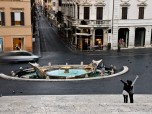Campo de’ Fiori means field of flowers, which his fitting, as this area was originally a meadow. Today, this square in Rome, Italy is known for its lively market. It is situated very close to the area called the Piazza Navona. The market sells fresh produce, breads, beverages and other kinds of items for tourists. This area was not developed for several centuries because the Tigris River used to flood the area.
History of the Square
The market’s history dates back to the early Middle Ages. It was first established at an area called the Forum Olitorium. Later, it moved to the Capitole Hill area, and then it relocated to the Piazza Navona. In 1869, it finally settled at its present location.
The square that is seen today began to take shape in the fifteenth century. A church called the Santa Brigida a Campo de’ Fiori was the square’s very first building. This church now faces the Piazza Farnese, which is an older section of the square. In 1456, part of the vicinity was paved because of the city’s improvement project. The work was begun because many important structures had already been built around the square, such as the Palazzo della Cancelleria and the Orsini Palace.
The architectural design of the Campo de’ Fiori was never formalized like most public squares in the city and across Europe. Thus, visitors will not see much continuity in the various types of buildings that are around the colorful, old piazza. The square has long been the focus for many different types of street and commercial cultural activities. In the past, the area had been a neighborhood for very wealthy individuals.
Statue of Giordani Bruno
For hundreds of years public executions were held at the Campo de’ Fiori. Many so-called heretics and criminals have been tortured or executed at the square. Many were hanged and others were burned to death. Some were even put into kettles that contained boiling oil.
One very famous individual that was executed at the square was Giordano Bruno, an Italian philosopher. In 1600, the Roman Inquisition had him burned alive because of some of the things he spoke about. Bruno had talked about how the stars in the universe were really suns.
In 1887, a sculpture named Ettore Ferrari created the statue of Giordano Bruno. It was positioned in the square so that it directly faced the Vatican. Today, he is considered to be a martyr and an advocate for the right of all people to have the freedom of expression. The statue has medallions on its pedestal of eight other “free-thinkers” such as John Wycliffe and Jan Hus.
The Market Area
Today, the market is still a very lively place and fresh produce is sold there every morning, except on Sundays. Flowers, spices and kitchenware products are also sold in the square. The fragrance of pizza and bread can found throughout the area. Every year, many local people and tourists enjoy shopping and dining at Rome’s oldest market.





































